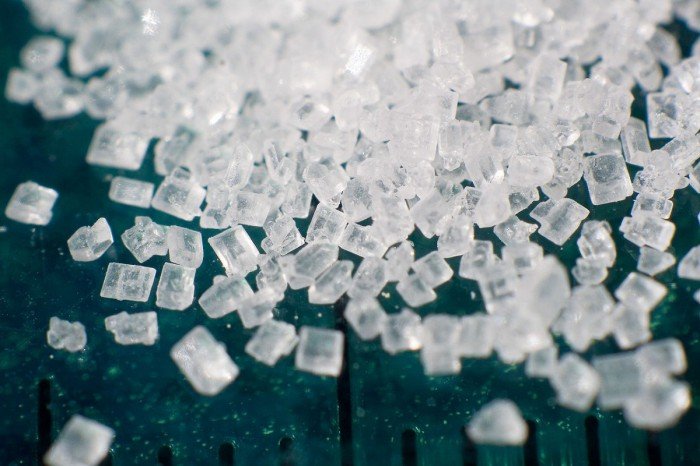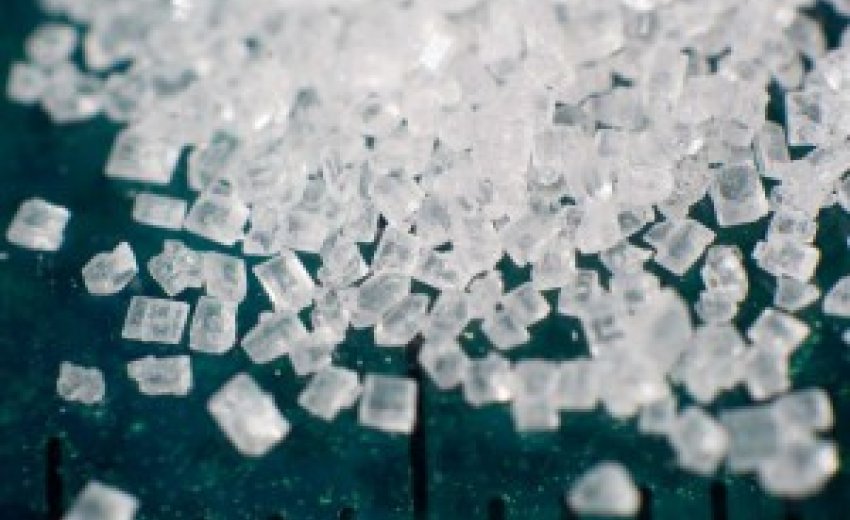
April 16, 2014: Sugar seems to be a sensitive topic these days. It’s in everything, but somehow we’ve come up with this notion to go completely “anti-sugar/no sugar.” While that’s just not possible since grains, vegetables, and fruit all contain some sugar, you can lean towards “no added sugar.” A no-added sugar lifestyle (with maybe a treat every once in awhile) is a better goal. What health experts are trying to convey is that white, refined sugar is now under scrutiny.
Sound the alarm, because this stuff is in almost everything we buy from the store, often times disguised as high fructose corn syrup. Sugar raises cause for concern because studies have now shown that it’s linked to the onset of many health problems such as weight, heart, and bone issues, to name just a few. Even more concerning is that sugar is addictive so you can’t help but to go back for more. However, it’s important to understand the difference between these processed products and sugar from more natural sources like various fruits. Mainly, processed products are loaded with sugar and lack the nutritional value whole foods have. And although some whole foods may contain a similar sugar count to their processed counterpart, whole foods offer many more health benefits when part of a balanced diet than any processed food. With that in mind, check out these 10 processed food products loaded with sugar, combined with a suggestion for an alternative whole food option:
1. Cereal vs. Homemade Granola
Even the healthy-sounding cereals are high in sugar! A 3/4 cup of Kellogg’s Cracklin’ Oat Bran contains 15 grams of sugar. And let’s be real, how long does a little bowl of box cereal keep you full? In the morning, try to swap out store-bought cereals for something homemade.
Granola is a great way to start the day and it’s super versatile, super filling, and super easy to make. Mix together some oats with your favorite nuts and seeds, bake in the oven for a bit (if you’re into that), and boom — you’ve got yourself a delicious breakfast. Try out this goji berry granola recipe which uses real maple syrup as a sweetener. In a 3/4 cup serving of this granola, there is about 19 grams of sugar. Yes, that’s more than the oat bran cereal and sugar is sugar BUT your homemade granola contains many more health benefits. For instance, goji berries pack an antioxidant punch while pepitas, sunflower seeds, and chia seeds include heart-healthy fats and not to mention, hemp hearts are full of protein. Also, maple syrup itself contains more iron, calcium, zinc, manganese, and potassium than plain white sugar or high fructose corn syrup. So there you go, always make sure to think about what you’re eating in a holistic way.
2. Candy vs. Dried Fruit
Next time you’re stuck at work and walk by that vending machine for the millionth time, come prepared! Save your loose change and forget that bag of Skittles. Instead, pack a little treat for that afternoon slump. Enjoy nature’s candy a.k.a raisins. One bag of Skittles has 42 grams of sugar while 1/4 cup of raisins, or one of those little boxes, only has 29 grams of sugar. Forget about tasting the rainbow when you can reap antioxidant benefits from those raisins.
3. Frozen Waffles vs. Homemade Waffles
Next time you’re over at a friend’s and they go to pop a frozen waffle in the toaster after a long night, offer to make them breakfast before they move another inch. No one can turn down homemade waffles, especially not these mango ones. Eggo Cinnamon Toast Waffles contain 17 grams of sugar while the sweetener in the aforementioned recipe contains 1 cup of mango puree with 14 grams of sugar. Mango puree is super easy to make yourself with frozen mango chunks — just thaw, blend, and you’re done!
4. Instant Oatmeal vs. Stove-top Oatmeal
Instant oatmeal packets are sneaky… you think oatmeal always equals healthy, but be wary of the sugar count! Quaker’s Instant Strawberries & Cream oatmeal and Instant Peaches & Cream oatmeal packets both have 12 grams of sugar in that tiny envelope. Plan your morning out and wake up those five to ten minutes earlier to make stove-top oatmeal. It’s worth it. For sweetness, try swirling in (no sugar added) applesauce and cinnamon. A 1/4 cup of natural applesauce has less than 10 grams of sugar.
5. Store-bought Frosting vs. Homemade Frosting
Next time you bake a cake, show off your skills and top it off with homemade frosting rather than Betty Crocker’s Rich and Creamy Chocolate Frosting. This premade variety has 17 grams of sugar per serving. But, this homemade fudgy frosting uses coconut nectar as a sweetener which has 13 grams of sugar per serving.
6. Canned Fruit vs. Whole Fruit
Even if you go out of your way to buy the cans or packages of fruit “in light syrup,” you’re still getting some unnecessary sugar. Dole diced peaches in light syrup contains 18 grams of sugar! Next time, stick to whole fruit; one peach has half of what’s in the can — only 9 grams of sugar.
7. Pudding Cups vs. Chia Pudding
Most processed pudding cups out there are packed with sugar. To cut down, try out this chocolate raspberry chia pudding! This recipe uses medjool dates for sweetness. One serving of this chia pudding contains about 1 and 1/2 dates which contain around 16 grams of sugar. Feel free to experiment with your own chia pudding!
8. Store-bought Smoothies vs. Homemade Smoothies
Smoothies are popping up everywhere: restaurants, gyms, mall stands, even vending machines sometimes offer Naked Juice Smoothies. Don’t be fooled into thinking that these are all healthy choices though! Often times, whenever you purchase a smoothie while on the go, your new drink will contain a lot of added sugar. It’s much safer to make your own. One Naked Juice Smoothie has 24 grams of sugar per serving and there are TWO servings in the whole bottle. And really, who doesn’t drink the whole bottle? When making your own smoothie, be smart about it. Go easy on the agave. Whole fruit is best to add. Test out this strawberry shortcake smoothie with a little more than 12 grams of sugar from the strawberries and coconut combined.
9. Ice Cream vs. Frozen Bananas
Ice cream, and sadly especially vegan ice cream (sorbet included), is loaded with sugar. Vegan ice creams contain around 17 grams of sugar while sorbet can have more than 30 grams in one serving! Start experimenting with frozen bananas and soon you’ll wonder why you even spent the big bucks on pints. One banana contains around 14 grams of sugar. Peel it, place it in a baggie, and pop it in the freezer. Once it’s completely frozen, simply blend in a food processor. Feel free to add any spices or extracts for additional flavor but it also hits the spot plain!
10. Jarred/Canned Spaghetti Sauce vs. Homemade Marinara
Sauce goes hand in hand with savory dishes but don’t overlook the amount of sugar in jarred or canned tomato sauces! The amount of sugar varies from brand to brand so if you’re in a rush and find one with little added sugar, go for it. But, if your store only carries those with upwards of 12 grams of sugar per serving, experiment with making your own. This marinara sauce recipe is easy and has a little more than one cup of tomatoes per serving which contains only 5 grams of sugar. You can’t go wrong with homemade sauce!
In general:
When cooking and baking, sugar is often added only for flavor. If you cut down on proportions, texture and consistency often will not be affected. For example, if you’re baking cookies and the recipe calls for a full cup of sugar, only add 1/3 cup. Then to enhance flavor, play with adding sweet spices such as vanilla, cinnamon, nutmeg, or mint!
Reference: Sugar Shockers/WebMD
Image source: GFDL / Wikimedia Commons
